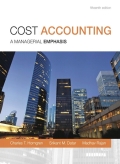
Cost Accounting
15th Edition
ISBN: 9780133428834
Author: Horngren
Publisher: PEARSON
expand_more
expand_more
format_list_bulleted
Concept explainers
Textbook Question
Chapter 17, Problem 17.5Q
Name the five steps in
Expert Solution & Answer
Learn your wayIncludes step-by-step video

schedule02:47
Students have asked these similar questions
Need answer
Solve this?
What markup percentage is the company using?
Chapter 17 Solutions
Cost Accounting
Ch. 17 - Give three examples of industries that use...Ch. 17 - In process costing, why are costs often divided...Ch. 17 - Explain equivalent units. Why are equivalent-unit...Ch. 17 - What problems might arise in estimating the degree...Ch. 17 - Name the five steps in process costing when...Ch. 17 - Name the three inventory methods commonly...Ch. 17 - Describe the distinctive characteristic of...Ch. 17 - Describe the distinctive characteristic of FIFO...Ch. 17 - Prob. 17.9QCh. 17 - Identify a major advantage of the FIFO method for...
Ch. 17 - Identify the main difference between journal...Ch. 17 - The standard-costing method is particularly...Ch. 17 - Why should the accountant distinguish between...Ch. 17 - Transferred-in costs are those costs incurred in...Ch. 17 - Theres no reason for me to get excited about the...Ch. 17 - Prob. 17.16ECh. 17 - Prob. 17.17ECh. 17 - Prob. 17.18ECh. 17 - Prob. 17.19ECh. 17 - Prob. 17.20ECh. 17 - Prob. 17.21ECh. 17 - Prob. 17.22ECh. 17 - Prob. 17.23ECh. 17 - Prob. 17.24ECh. 17 - Prob. 17.25ECh. 17 - Prob. 17.26ECh. 17 - Prob. 17.27ECh. 17 - Prob. 17.28ECh. 17 - Prob. 17.29ECh. 17 - Prob. 17.30PCh. 17 - Prob. 17.31PCh. 17 - Prob. 17.32PCh. 17 - Prob. 17.33PCh. 17 - Prob. 17.34PCh. 17 - Prob. 17.35PCh. 17 - Prob. 17.36PCh. 17 - Prob. 17.37PCh. 17 - Prob. 17.38PCh. 17 - Prob. 17.39PCh. 17 - Prob. 17.40PCh. 17 - Prob. 17.41PCh. 17 - Benchmarking, ethics. Amanda McNall is the...Ch. 17 - Prob. 17.43P
Additional Business Textbook Solutions
Find more solutions based on key concepts
(Record inventory transactions in the periodic system) Wexton Technologies began the year with inventory of 560...
Financial Accounting (12th Edition) (What's New in Accounting)
11. Which assumed inventory cost flow method:
usually parallels the actual physical flow of merchandise?
divide...
Financial Accounting: Tools for Business Decision Making, 8th Edition
3. Which method almost always produces the most depreciation in the first year?
a. Units-of-production
b. Strai...
Horngren's Financial & Managerial Accounting, The Financial Chapters (Book & Access Card)
What is a qualitative forecasting model, and when is its use appropriate?
Operations Management
The amount owned by the short call option holder. Introduction: Option is a contract to purchase a financial as...
Corporate Finance (4th Edition) (Pearson Series in Finance) - Standalone book
Quick ratio (Learning Objective 7) 510 min. Calculate the quick assets and the quick ratio for each of the foll...
Financial Accounting, Student Value Edition (5th Edition)
Knowledge Booster
Learn more about
Need a deep-dive on the concept behind this application? Look no further. Learn more about this topic, accounting and related others by exploring similar questions and additional content below.Similar questions
arrow_back_ios
SEE MORE QUESTIONS
arrow_forward_ios
Recommended textbooks for you
- Principles of Accounting Volume 2AccountingISBN:9781947172609Author:OpenStaxPublisher:OpenStax College
 College Accounting, Chapters 1-27AccountingISBN:9781337794756Author:HEINTZ, James A.Publisher:Cengage Learning,
College Accounting, Chapters 1-27AccountingISBN:9781337794756Author:HEINTZ, James A.Publisher:Cengage Learning,

Principles of Accounting Volume 2
Accounting
ISBN:9781947172609
Author:OpenStax
Publisher:OpenStax College

College Accounting, Chapters 1-27
Accounting
ISBN:9781337794756
Author:HEINTZ, James A.
Publisher:Cengage Learning,
Cost Classifications - Managerial Accounting- Fixed Costs Variable Costs Direct & Indirect Costs; Author: Accounting Instruction, Help, & How To;https://www.youtube.com/watch?v=QQd1_gEF1yM;License: Standard Youtube License